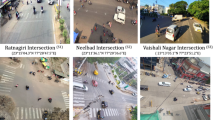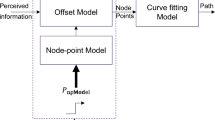Abstract
In China, F-type-5 m intersections are not uncommon. One approach of these intersections usually includes a driveway closely followed by an intersecting street, and the driveway and the intersecting street are parallel and approximately 5 m apart. Nowadays, drivers often rely on the navigation systems for directions. However, it is found that the navigation systems sometimes mislead or confuse drivers to make wrong turns or miss their turns at such F-type-5 m intersections. This study proposed to employ driving simulation to identify the appropriate prompt message delivered at the right prompt timing to help drivers navigate through such F-type-5 m intersections. First, a within-subjects two-factor experiment was designed. One factor was the Prompt Timing Mode (PTM), representing a set of three sequential messages broadcast by the navigation system at varying distances to the intended intersection; the other factor was the Prompt Message Type (PMT), representing various sets of three sequential messages broadcast by the navigation system. Three Prompt Timing Modes were used: PTM1 = {− 400 m, -200 m, − 30 m}, PTM2 = {− 300 m, − 150 m, − 30 m}, and PTM3 = {− 200 m, − 100 m, − 30 m}. Three Prompt Message Types were defined: PMT-A = {Turn right at the traffic light XXm ahead; Turn right at the traffic light XXm ahead; Turn right}, PMT-B = {Turn right at the traffic light XXm ahead, enter YY street; Turn right at the traffic light XXm ahead, enter YY street; Turn right}, PMT-C = {Turn right at the traffic light XXm ahead, enter YY street, and please use the second right turn lane; Turn right at the traffic light XXm ahead, enter YY street, and please use the second right turn lane; Turn right}. The combinations of the two factors generated nine experimental intersections which were randomly assigned to three experimental routes. Then, a total of 37 drivers were recruited, and participated in the driving simulation experiment from which vehicle operation data were collected under different prompt timing modes and message types. Next, the repeated Analysis of Variance (rANOVA) was performed to examine the effects of different prompt timing modes and prompt message types on vehicle operation indicators, such as Driving Time, Standard Deviation of Speed, Absolute Value of Acceleration, and Standard Deviation of Acceleration. Finally, the grey near-optimal method was adopted to evaluate the effectiveness of three prompt message types under each prompt timing mode. The rANOVA results showed the vehicle operation in the F-type-5 m intersection was affected by prompt timing modes and prompt message types; the evaluation results indicated that PMT-C made drivers perform better in PTM1 and PTM3, while PMT-B made drivers perform better inPTM2. However, the effectiveness of PMT-A was the lowest in each prompt timing mode. The research results provide valuable guidance to design the human machine interface of navigation systems, which can help drivers safely navigate through F-type-5 m intersections. This research also has laid solid foundations for establishing navigation messaging design guidelines.










Similar content being viewed by others
References
AQSIQ and SA (2019) The National Standard of the P.R. China: Road Signs and Markings (GB5768-2009). http://www.doc88.com/p-3701701707998.html. Accessed May 26, 2019
Bendak S, Al-Saleh K (2010) The role of roadside advertising signs in distracting drivers. Int J Ind Ergon 40:233–236
Burnett G (2000) ‘Turn right at the Traffic Light’: the Requirement for Landmarks in Vehicle Navigation Systems. J Navigat 53:499–510
Chen CF, Chen PC (2011) Applying the tam to travelers’ usage intentions of GPS devices. Expert Syst Appl 38(5):6217–6221
Chi J, Zhao X, Rong J, Xu F (2015) A study of signs design at the unattended freeway toll stations based on simulated drving experiments. J Trans Inform Saf 33(195):114–119
Ding H, Zhao X, Rong J, Ma J (2015) Experimental research on the effectiveness and adaptability of speed reduction markings in downhill sections on urban roads: a driving simulation study. Accid Anal Prev 75:119–127
Fan Z, Chen D, Zhao X (2017) An effective evaluation of yellow flashing warning light of intersection based on an efficiency coefficient method. J Trans Inform Saf 35(207):91–98
GNSS & LBS Association of China. (2018). How many users of satellite navigation terminals are there in the world?. http://www.glac.org.cn/index.php?m=content&c=index&a=show&catid=38&id=4540. Accessed May 6, 2019
Hu L (2017) Research on the influence of navigation function of smart phone on driving performance. Master Degree, Chang’an University
Hu R (2018) Research on ecological interface design of automobile auxiliary driving system based on cognitive load theory. Anhui University of Technology
Huang L, Zhao X, Li Y, Rong J (2018) Optimal setting methods of complex diagrammatic guide signs on urban expressway, China. J Highway Transport 031(004):139–146
Jahn G, Oehme A, Krems JF, Gelau C (2005) Peripheral detection as a workload measure in driving: effects of traffic complexity and route guidance system use in a driving study. Transport Res F 8:0–275
Jalayer M, Zhou H, Zhang B (2016) Evaluation of navigation performances of GPS devices near interchange area pertaining to wrong-way driving. J Traffic Transport Eng 3:593–601
Jensen BS, Skov MB, Thiruravichandran N (2010) Studying driver attention and behaviour for three configurations of GPS navigation in real traffic driving. Proceedings of the 28th International Conference on Human Factors in Computing Systems, New York, USA
Jeon M, Gable TM, Davison BK, Nees MA, Wilson J, Walker BN (2015) Menu Navigation with In-Vehicle Technologies: auditory Menu Cues Improve Dual Task Performance, Preference, and Workload. Int J Human-Comput Interact 31:1–16
Jing M, Sun J (2015) Grey premium evaluation of several kinds of fabric style and wearability. Cotton Textile Technol 43:72–76
Ke H, Chen Y, Xia B (2007) A multi-objective decision-making algorithm based on approximation to ideal grey relational projection. Acta Electron Sin 35:1757–1761
Lee WC, Cheng BW (2010) Comparison of portable and onboard navigation system for the effects in real driving. Saf Sci 48(10):1421–1426
Lee WC, Chens BW (2008) Effects of using a portable navigation system and paper map in real driving. Accident Anal Prevent 40(1):303–308
Li P (2010) Research on indices and analysis of driving behavior, Doctoral dissertation Changchun: Jilin University
Li X (2014) Comprehensive evaluation of cotton knitted wear performance after finishing with different softeners. Shandong Textile Econ 06:31–35
Li Z, Pan W (2010) Econometrics, 3rd edn. Higher Education Press, Beijing
Liu YC, Wen MH (2004) Comparison of head-up display (HUD) vs. head-down display (HDD): driving performance of commercial vehicle operators in Taiwan. Int J Human Comput Stud 61:679–697
Park E, Kim KJ (2014) Driver acceptance of car navigation systems: integration of locational accuracy, processing speed, and service and display quality with technology acceptance model. Pers Ubiquit Comput 18:503–513
Park E, Kim H, Ohm JY (2015) Understanding driver adoption of car navigation systems using the extended technology acceptance model. Behav Inform Technol 34:1–11
Rasker PC, Post WM, Schraagen JMC (2000) Effects of two types of intra-team feedback on developing a shared mental model in command & control teams. Ergonomics 43:1167–1189
Ross T, Brade S (1995) An empirical study to determine guidelines for optimum timing of route guidance instructions. IEE Colloquium on Design of the Driver Interface, London
Kanevsky D, Churchill B, Faisman A, Nahamoo D, Sicconi, R (2004) Safety driver manager. In Proceedings of the 9th conference speech and computer, September 20–22, Russia
Srinivasan R, Jovanis PP (1997) Effects of selected in-vehicle route guidance systems on drivers reaction times. Hum Factors 39:200–215
Tversky A, Kahneman D (1973) Availability: a heuristic for judging frequency and probability. Cogn Psychol 5:207–232
Uang ST, Hwang SL (2003) Effects on driving behavior of congestion information and of scale of in-vehicle navigation systems. Transport Res C 11:423–438
Vanderhaegen F (2012) Cooperation and learning to increase the autonomy of adas. Cogn Technol Work 14(1):61–69
Vanderhaegen F (2016) A rule-based support system for dissonance discovery and control applied to car driving. Exp Syst Appl 65:361–371
Walker J, Alicandri E, Sedney C, Roberts K (1991) In-Vehicle Navigation Devices: Effects on the Safety of Driver Performance. Proceedings of the 2nd IEEE Vehicle Navigation & Information Systems Conference, New York, USA
Wu CF, Huang WF, Wu, TC (2009) A Study on the design of voice navigation of car navigation system. Proceedings of the 13th International Conference on Human-Computer Interaction, San Diego, California, USA
Wu Y, Wu Z (2008) A safety analysis method for highway based on average speed and speed standard deviation. J Highway Transport Res Develop 25(3):139–142
Yuan W, Fu R, Guo Y, Zhang J (2007) Experiment on perception—decision—adjustment operation mode of automobile drivers. J Chang’an Univ 27(3):80
Yun M, Zhao J, Zhao J, Weng X, Yang X (2017) Impact of in-vehicle navigation information on lane-change behavior in urban expressway diverge segments. Accid Anal Prev 106:53–66
Zhang J, Suto K, Fujiwara A (2009) Effects of in-vehicle warning information on drivers’ decelerating and accelerating behaviors near an arch-shaped intersection. Accid Anal Prev 41(5):948–958
Zhao X, Li J, Ding H, Zhang G, Rong J (2015a) A generic approach for examining the effectiveness of traffic control devices in school zones. Accid Anal Prev 82:134–142
Zhao X, Wu Y, Rong J, Ma J (2015b) The effect of chevron alignment signs on driver performance on horizontal curves with different roadway geometries. Accid Anal Prev 75:226–235
Zhao X, Ding H, Lin Z, Ma J, Rong J (2018) Effects of longitudinal speed reduction markings on left-turn direct connectors. Accid Anal Prev 115:41–52
Zhao X, Ren G, Wang B, Chen Z (2020) Evaluation of a transport hub sign system based on BIM + VR technology. J Beijing Univ Technol 46(1):51–57
Zheng R, Nakano K, Ishiko H, Hagita K (2015) Eye-gaze tracking analysis of driver behavior while interacting with navigation systems in an Urban Area. IEEE Trans Human Mach Syst 46:546–556
Zhu T, Wu L, Lu QZ (2015) Effects of in-vehicle information on driver eye blink duration and workload. J Southwest Jiaotong Univ 50:504–510
Acknowledgements
This research was funded by Traffic & Transportation Standard Project (Grant No. 2018-16-017): Speech Navigation Information Service Term for Vehicle Travel.
Author information
Authors and Affiliations
Corresponding author
Additional information
Publisher's Note
Springer Nature remains neutral with regard to jurisdictional claims in published maps and institutional affiliations.
Rights and permissions
About this article
Cite this article
Yang, L., Bian, Y., Zhao, X. et al. Experimental research on the effectiveness of navigation prompt messages based on a driving simulator: a case study. Cogn Tech Work 23, 439–458 (2021). https://doi.org/10.1007/s10111-020-00645-w
Received:
Accepted:
Published:
Issue Date:
DOI: https://doi.org/10.1007/s10111-020-00645-w




